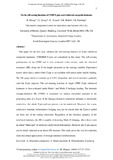JavaScript is disabled for your browser. Some features of this site may not work without it.
| dc.contributor.author | Zhang, B. | |
| dc.contributor.author | Allegri, Giuliano | |
| dc.contributor.author | Yasaee, Mehdi | |
| dc.contributor.author | Hallett, Stephen R. | |
| dc.contributor.author | Partridge, Ivana K. | |
| dc.date.accessioned | 2017-03-22T10:34:35Z | |
| dc.date.available | 2017-03-22T10:34:35Z | |
| dc.date.issued | 2016-03-19 | |
| dc.identifier.citation | B. Zhang, G. Allegri, M. Yasaee, S.R. Hallett, I.K. Partridge, On the delamination self-sensing function of Z-pinned composite laminates, Composites Science and Technology, Volume 128, 18 May 2016, pp138-146 | en_UK |
| dc.identifier.issn | 0266-3538 | |
| dc.identifier.uri | http://dx.doi.org/10.1016/j.compscitech.2016.03.019 | |
| dc.identifier.uri | https://dspace.lib.cranfield.ac.uk/handle/1826/11635 | |
| dc.description.abstract | This paper investigates for the first time the usage of through-thickness reinforcement for delamination detection in self-sensing composite laminates. Electrically conductive T300/BMI Z-pins are considered in this study. The through-thickness electrical resistance is measured as the delamination self-sensing variable, both for conductive and non-conductive laminates. The Z-pin ends are connected to a resistance measurement circuit via electrodes arranged on the surface of the laminate. The delamination self-sensing function enabled by conductive Z-pins is characterised for Mode I/II delamination bridging, using single Z-pin coupons. Experiment results show that, if the through-thickness reinforced laminate is electrically conductive, the whole Z-pin pull-out process associated with delamination bridging can be monitored. However, for a non-conductive laminate, delamination bridging may not be sensed after the Z-pin is pulled out from one of the surface electrodes. Regardless of the electrical properties of the reinforced laminate, the through-thickness electrical resistance is capable of detecting Mode II bridging, albeit there exists an initial “blind spot” at relatively small lateral deformation. However, the Z-pin rupture can be clearly detected as an abrupt resistance increase. This study paves the way for exploring multi-functional applications of through-thickness reinforcement. | en_UK |
| dc.language.iso | en | en_UK |
| dc.publisher | Elsevier | en_UK |
| dc.rights | Attribution-Non-Commercial-No Derivatives 3.0 Unported (CC BY-NC-ND 3.0). You are free to: Share — copy and redistribute the material in any medium or format. The licensor cannot revoke these freedoms as long as you follow the license terms. Under the following terms: Attribution — You must give appropriate credit, provide a link to the license, and indicate if changes were made. You may do so in any reasonable manner, but not in any way that suggests the licensor endorses you or your use. Information: Non-Commercial — You may not use the material for commercial purposes. No Derivatives — If you remix, transform, or build upon the material, you may not distribute the modified material. No additional restrictions — You may not apply legal terms or technological measures that legally restrict others from doing anything the license permits. | |
| dc.subject | Structural composites | en_UK |
| dc.subject | Smart materials | en_UK |
| dc.subject | Delamination | en_UK |
| dc.subject | Z-pinning | en_UK |
| dc.title | On the delamination self-sensing function of Z-pinned composite laminates | en_UK |
| dc.type | Article | en_UK |
Files in this item
This item appears in the following Collection(s)
-
Staff publications (SATM) [4364]
